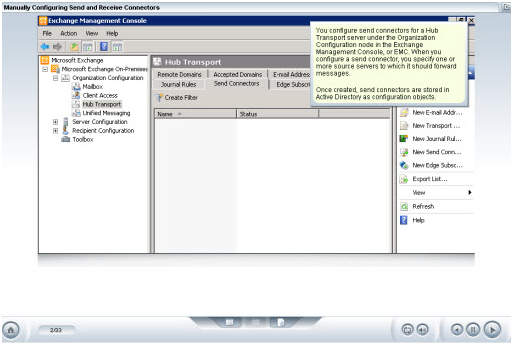Our training for Exchange Server 2007 MCTS covers how to plan and prepare a network infrastructure for an Exchange Server 2007 installation as well as deploy it. Configuring e-mail recipients, monitoring the Exchange environment, and preparing for and recovering from disasters are also covered.
This course covers the objectives for the Microsoft exam: 70-236 TS: Microsoft Server Exchange 2007, Configuring. Passing this exam indicates your ability to support messaging solutions in an organization. This training program will prepare you to earn the Microsoft Certified Technology Specialist (MCTS): Server 2007 designation, which will demonstrate your expertise in this area.
 Our Training Includes Our Training Includes
Multi Media Interactive Training lessons
Training Outline
Preparing the Exchange Server 2007 Infrastructure
- Basic capabilities
- Distinguish between editions
- Key features and their functions
- Main requirements
- Determine needs and responsibilities when deploying Exchange Server 2007
- Planning the network infrastructure
- Plan server implementation
- Choose server roles in an Exchange Server 2007 system
- Design an Exchange Server 2007 deployment
Installing and Transitioning to Exchange Server 2007
- Sequence preinstallation tasks
- Complete a typical installation of Exchange Server 2007
- Perform a custom installation
- Typical installation
- Strategy to use when migrating from Windows 2000 Server to Windows 2003 Server
- Transition from Exchange 2000 Server or Exchange Server 2003 to Exchange Server 2007
- Process for transitioning to Exchange Server 2007
Managing Exchange Server 2007
- Install the management tools
- Administrative capabilities
- Work with the Management Shell
- Customize a console window
- Use the EMS
- Create and edit an e-mail address policy
- Work with mailboxes
- Manage resource mailboxes
- Create mail-enabled groups and dynamic distribution groups
- Create mail-enabled contacts
- Manage global address lists
- manage Exchange Server 2007 Recipients
Managing Default, Custom, and Public Folders in Exchange Server 2007
- Manage the content in default folders
- Custom folders
- Perform public folder management tasks
- Recognize how users can work with public folders using Outlook 2007
- Manage public folders
Public folder replication process
- Connectors, Transport Rules, and Message Compliance in Exchange Server 2007
- Distinguish between connectors
- Send Connectors on the Hub Transport server
- Receive connectors on the Edge Transport server
- Create Send connectors on the Edge Transport server
- Configure a Send connector on the Hub Transport server
- Configure Receive connectors on the Edge Transport server
- Message classifications
- Transport rules
- How to use journaling
- Implement a message classification
- Create a transport rule
Accessing Exchange Server 2007 Remotely
- Configure Outlook Web Access
- Exchange support for ActiveSync and define ActiveSync policies
- Outlook Web Access
- Exchange to support ActiveSync and define ActiveSync policies
- Configure Exchange Server 2007 for Outlook Anywhere
- Manually configure the Outlook Client for Outlook Anywhere
- Configure Exchange Server 2007 for POP3 and IMAP4 clients
- How to configure POP3, IMAP4, and SMTP clients
- Configure Exchange Server 2007 and the Outlook client for Outlook Anywhere
- Configure Exchange Server 2007 for POP3 clients
Data Protection in Exchange Server 2007
- CCR mailbox cluster
- Client Access servers into an NLB cluster
- Configure LCR on a storage group and recover it in the event of a system failure
- Deploy high-availability technologies on Exchange Server 2007
- Develop a backup strategy for Exchange Server 2007
- Back up Exchange 2007 servers
- Verify backups
Disaster Recovery with Exchange Server 2007
- Recover from common disasters in an Exchange Server 2007 environment
- Prepare for a recoverable Exchange Server 2007 environment
- Restore an Exchange Server 2007 mailbox database
- Recovery storage group when restoring mailbox databases
- Restore a database
- Restore a database using the recovery storage group
- Assess a disaster and determine how to recover from it
Monitoring and Security in Exchange Server 2007
- Monitoring features of MOM and their functions
- Perform auditing, logging, and message tracking
- Monitor the performance of Exchange Server 2007
- Monitoring tools
- Secure the servers
- Secure messages
- Install certificates
- Recognize how to monitor and secure the Exchange Server 2007 environment
Configuring Outlook 2007 for Exchange Server 2007
- Perform an installation of Outlook 2007
- Administrative tasks in Outlook 2007
- How Outlook 2007 locates an Autodiscover site
- Configure a resource mailbox
- Set a rule limit and quota
|











 Our Training Includes
Our Training Includes 